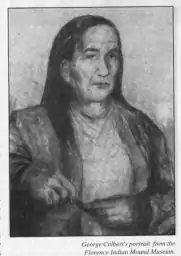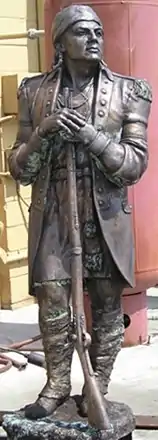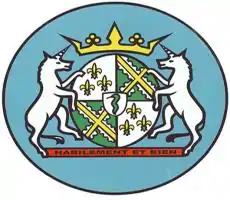George Colbert
Chief George Colbert, also known as Tootemastubbe (c. 1764–1839), was a Native American leader of the Chickasaw people in the early 19th century. He commanded 350 Chickasaw auxiliary troops, whom he had recruited, as a militia captain under Andrew Jackson during the Creek War of 1813-1814. Later he joined the US Army under Jackson for the remainder of the War of 1812.
George temporarily became chief of the Chickasaw again after his late brother Levi Colbert died in 1834. George was a planter who owned significant land in Mississippi, and a ferry in northwestern Alabama.
His father, James Logan Colbert, was half Scot, half Chickasaw. George was three-fourths Chickasaw and one quarter Scottish.[1]
Early life and education
The second of six mixed-race sons of James Logan Colbert, a North Carolinian son of a settler of Scots descent and his second wife Minta Hoye, a Chickasaw, George "Tootemastubbe" Colbert was born in present-day Alabama in 1764.[2] As a youth he began to rise in prominence in the Chickasaw nation, as he gained status from his mother's clan as well as his actions. The Chickasaw had a matrilineal kinship system, in which children were considered born into their mother's clan; positions of hereditary leadership were passed through the mother's line.
Military service
Colbert was said to serve with American troops under Arthur St. Clair in 1791 and Anthony Wayne in 1794 during the Northwest Indian Wars. During the Creek Wars, he recruited 350 Chickasaw warriors and assisted Andrew Jackson against the Red Sticks, and later during more of the War of 1812.[2]
Career
By the early 1800s, George "Tootemastubbe" Colbert established Colbert's ferry near Cherokee, Alabama. It was a significant crossing of the Tennessee River along the Natchez Trace, an important trade route. George Colbert was able to accumulate land and became an influential planter; he also raised livestock and was a trader as well as being the eldest son eligible for the position of Chief. The tribe owned an estimated 150 enslaved Africans as labor on their land as was custom with many intercultural tribes in the region. A few slaves escaped during the confusion of the eventual Trail of Tears.
He and his brothers, Levi and James, were among the primary negotiators of between his people and the United States government in the early 19th century.[2] The Chickasaw ended up ceding much of their land to the United States after Levi "Itawambamingo" Colbert had died en route to Washington D.C during negotiations in 1834. Being between both "white" and "native" cultures, he and his brother were heavily relied upon to act on the tribe's behalf, so once Levi died, negotiations abruptly ceased and in the year 1834, the Chickasaw joined many other tribes in removal (the Trail of Tears). Itawmaba County in Mississippi is named after Levi.
Before removal, George "Tootemastubbe" Colbert served again as chief of the Chickasaw temporarily. (The reason his younger brother served is due to George never truly wanting the position). The year 1834 was the beginning of the tedious and heart breaking path to the newly established Indian Territory. Tishomingo became chief of the Chickasaw once they started on the trail and remained in charge once they arrived until his death in 1838 en route. Neither he nor George, who died also en route in 1839 at age 75, ever reached the new territory alive. Tishomingo died near the Arkansas river in 1836; Tootemastubbe died just before arrival to the Chickasaw's new territory at Fort Towson (which is Choctaw territory located east of the Chickasaw).[2]
Marriage and family
George Colbert married two times. They were two sisters from the Wind Clan Cherokee, and he fathered a total of six sons and two daughters. Saleechie Doublehead, the daughter of Chief Doublehead was the younger sister of Tuskiahooto Doublehead and both were his wives. He solely married Saleechie due to the older sister being barren. (The Chickasaw allowed the men in the tribe to marry multiple wives per tribal law). George Colbert never arrived to the Chickasaw section of "Oka Homa". Several ancestry search sites state he died on the Trail of Tears at Fort Towson which is Choctaw territory. Saleechie Doublehead was a direct descendant of Pocohantas's youngest sister, "Cleopatra", as dubbed by John Rolfe.
His father, James Logan Colbert, was the first child of mixed blood due to his father, Major William d'Blainville "Piomingo" Colbert (born 1695, died after 1792 and buried on Isle of Skye) coming to the new world in the early 1720s and marrying the Chickasaw chief's daughter, Mimey "Dorothy" Colbert. This marriage made William's negotiations for trade easier due to her influence and position in the tribe. James Logan Colbert was born from this union as William had only married one wife in accordance to the Catholic faith. Major William received his commission as an Army Officer from President George Washington himself in 1786 along with his grandson, General William "Chootshemataha" Colbert.
Look up Chief Piomingo, Major William d'Blainville Colbert; Blainville-sur-Orne, France; Chateau d'Colbert in Blainville; Jacobite Uprisings; Massacre of Glencoe.
Addendum: (William "d'Blainville" Colbert is so called since he was one of the first of the Castlehill Colberts of Inverness to be born outside Scotland in Blainville-sur-Orne, France, in 1695. The Chateau de Colbert is located in Blainville; it was one of the properties once owned by the deceased Jean-Baptiste Colbert, a cousin, who served as King Louis XIV's Treasurer in the mid-1600s. The Colberts/Cuthbert's of Castlehill, Inverness, Scotland had to leave due to the original Jacobite uprising, the Glorious Revolution,(also known as the Massacre of Glencoe) which ousted Roman Catholic King James II of England and VII of Scotland to be replaced by his Protestant daughter Mary II and William of Orange finally in 1692. The Jacobite Uprisings of 1689-1692 shed the blood of 30 members of another close family to King James II (and VII), the Clan MacDonald of Glencoe, so the "King Baron" Colberts had to find sanctuary in France. The Colbert family were heavily intertwined/intermarried with the Catholic Stuart family.
 Chief George "Tootesmastube" Colbert circa 1830
Chief George "Tootesmastube" Colbert circa 1830


Chateau de Colbert in Blainville-Sur-Orne, France
 Crest representing Colbert family ownership of Chateau;
Unicorns are Scotland's National "Animal"; blue similar to St. Andrews Flag of Scotland
Crest representing Colbert family ownership of Chateau;
Unicorns are Scotland's National "Animal"; blue similar to St. Andrews Flag of Scotland
Colbert Scottish Coat of Arms during Jacobite Uprisings
Legacy
- Colbert County, Alabama was named after George and his brother Levi.[3]
- George's Cave, near Colbert's Spring (named after Levi), was named after George Colbert.[4]
(The county of Itawamba County, Mississippi was named after his brother, Levi Colbert. Tishomingo County, Mississippi was named for the new and last chief who took over once the tribe embarked on the Trail of Tears. (Mingo is the Chickasaw word for "Chief"). NW Alabama and NE Mississippi is the region where the Chickasaw resided before 1834 and where these counties can be found.)
- Colbert, Oklahoma was named generally after the family in recognition of their contributions and blood lines tied to the Chickasaw. It's a very small town near the Texas border in the Red River Valley of song fame. It's not a part of the tribal seats such as Ada, OK and Ardmore, OK. The Chickasaw were one of the original Five Civilized Tribes.
References
- "Profile of Chickasaw Chief George (Tootemastubbe) Colbert". MyHeritage.com. Retrieved 11 December 2018.
- Pate, James P., "George Colbert," Encyclopedia of Oklahoma History and Culture (accessed November 3, 2009).
- Owen, Thomas McAdory; Owen, Marie (1921). History of Alabama and Dictionary of Alabama Biography. S.J. Clarke Publishing Company. pp. 302.
- Owen, Thomas McAdory; Owen, Marie (1921). History of Alabama and Dictionary of Alabama Biography. S.J. Clarke Publishing Company. pp. 235.
Further reading
- Arrell M. Gibson, The Chickasaws (Norman: University of Oklahoma Press, 1971).
- Don Martini, Who Was Who Among the Southern Indians: A Genealogical Notebook (Falkner, Miss.: N.p., 1997).
External links
- "Colbert, George", Encyclopedia of Oklahoma History and Culture